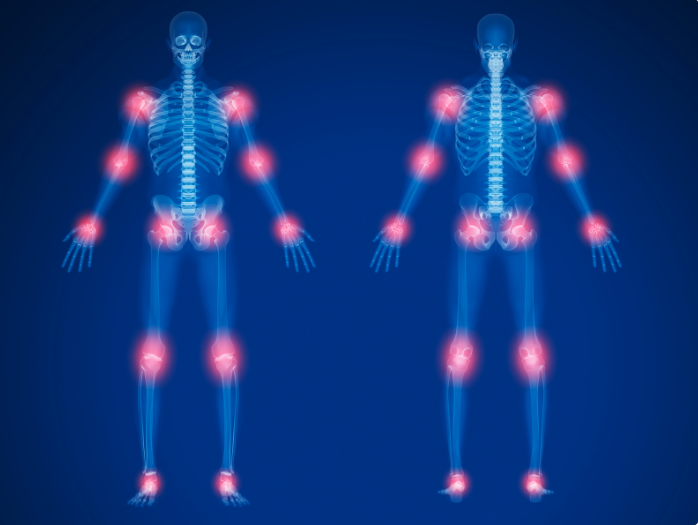
When coming across the terms osteoarthritis and osteoarthrosis, you might be wondering what these terms mean or whether or not they refer to the same condition. However, while osteoarthritis and osteoarthrosis sound extremely similar, they are actually different orthopedic conditions!
First, it might be helpful to break down the terms osteoarthritis and osteoarthrosis in order to determine what they mean and how they are different.
Osteoarthritis:
- “Osteo,” or the Greek word for ‘bone’ and
- “-itis,” which means ‘inflammation’
Osteoarthrosis:
- “Arthro-,” which is a prefix meaning ‘joint,’ and
- “-osis,” meaning ‘disease process or condition’
While many medical societies consider these two terms interchangeable and synonymous, osteoarthrosis is technically any noninflammatory arthritic condition that results in similar degenerative changes as in osteoarthritis, such as TMJ and other conditions. Additionally, even though osteoarthritis has traditionally been classified as a non-inflammatory disease, as the immune system is studied, many medical professionals are questioning that classification.
Osteoarthritis
Typically, people are most familiar with the term ‘arthritis.’ This is a more general term for conditions that affect the joints or the tissue around a joint. There are many different types of arthritis, including:
- Rheumatoid Arthritis – An autoimmune and inflammatory disease, which means that your immune system attacks healthy cells in your body by mistake, causing inflammation (painful swelling) in the affected parts of the body.
- Juvenile Arthritis – Arthritis that appears in children most likely due to the immune system not functioning properly, which causes inflammation in the joints and other body systems.
- Psoriatic Arthritis – A chronic inflammation of the skin and joints that causes pain, stiffness, and swelling in affected joints that sometimes occurs alongside psoriasis, which is a chronic autoimmune skin disease that speeds up the growth cycle of skin cells.
Osteoarthritis is the most common form of arthritis. It occurs when there is increased pressure on the joints that causes the cartilage within a joint to break down. This loss of cartilage – the flexible, protective tissue at the ends of bones – can cause the underlying bone to become exposed and subject to change over time.
Although osteoarthritis can damage any joint, the disorder most commonly affects joints in your hands, knees, hips and spine. The symptoms of osteoarthritis can include:
- Pain
- Stiffness
- Swelling
- Decreased joint movement
- Tenderness
Risk factors can include:
- Older age
- Gender (Women are more likely to develop osteoarthritis)
- Obesity
- Joint injuries
- Repeated stress on the joint
- Genetics
- Bone deformities
- Certain metabolic diseases including diabetes and hemochromatosis, a condition where your body has too much iron
- Occupation
How to Help Prevent and Treat Osteoarthritis
While it might not be possible to fully prevent osteoarthritis, there are some preventative measures that can decrease the likelihood of developing osteoarthritis or stop it from getting worse.
- Maintain a healthy body weight
- Control blood sugar
- Avoid injury to your joints
- Exercise daily
Treatment can vary from surgical to nonsurgical options depending on the condition of the patient and can include:
- Medication to relieve pain and reduce inflammation
- Physical or occupational therapy
- Cortisone injections
- Lubrication injections
- Joint replacement
Osteoarthrosis
Osteoarthrosis generally occurs in older adults as cartilage begins to deteriorate with age. Similar to osteoarthritis, this loss of cartilage can result in painful and damaging bone-to-bone contact within the joints.
Osteoarthrosis most commonly affects the knee, hip, and hand. It also has similar symptoms to osteoarthritis including:
- Pain
- Stiffness
- Decreased joint movement
Risk factors can include:
- Age
- Weight
- Genetics
- Occupation
- Joint deformities
Treatment of Osteoarthrosis
There is no way to completely prevent osteoarthrosis, however, there are ways to manage and treat symptoms, which include:
- Rest
- Weight loss
- Occupational therapy
- Supportive aids such as canes, crutches, shoe lifts, and elastic knee supports
- Physical therapy to help safely strengthen muscles around the affected joint
- Joint surgery
- Medication
Remember to consult your doctor for insight into your personal risk factors regarding osteoarthritis or osteoarthrosis. If you are at a higher risk for developing either one, it is important to maintain a healthy lifestyle and closely monitor the health of your joints. Make sure to contact your healthcare provider if any sudden or abnormal pain persists for a long period of time.
If you or someone you love suffers from arthritis or another disease or injury in the Louisville, Kentucky-area, board certified orthopedic surgeon Dr. Stacie Grossfeld at Orthopaedic Specialists PLLC can help. Orthopaedic Specialists PLLC is accepting new patients, and same day appointments are available. For additional information or to schedule an appointment, please contact Orthopaedic Specialists PLLC today at 502-212-2663.

Recent Comments